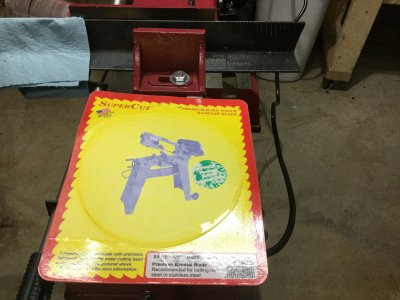I read that one last night and again earlier this morning. I haven't doen the wheelmchecks yet, just everything to do with the guide bearings.
A few more questions:
Loosening the feed spring seems to make the cut go faster. How fast should a cut be going through 2" of 1/8" mild steel?
If the cutting stops midway down does that mean the feed spring is too taught and it's holding the machine from advancing further?
My blade is just about square to the fence. The blade looks to be square to the table. If the blade is in fact square to the table and the blade tension is correct then what would be the next factor causing the blade to slope outwards as it cuts down?
Lastly, do all these machines make that cyclic noise per every revolution because of the blades weld joint? Mine is pretty loud.
First, I have to imagine every one of these saws acts radically different from the next as far as how they leave the factory.
The feed spring is probably the most fiddly, and (assuming everything is squared up) when I get cuts like that it tends to be too loose, with too much weight/force in the cut. YMMV.
From what I remember, the factory blade had a fine tooth on mine. Something like 20tpi or so, and it took FOOORREEVVERRRRR to cut even plastic. Now I use the 10-14 tpi bi-metal blade they sell (the $30 one, I forget the name brand it's been so long since I've had to buy one). For example, the stock blade that came with mine would take about 22 minutes to cut through 3"x5" 6061 aluminum. The 10-14 bimetal is about 3-4 minutes in the same cut.
Not sure how you have the guide set, but I would have the tightening knob outside of the slot. With half of the knob tightening on the outside of the casting, and the rest hanging out in the air ... if you will. This will get the guide close as possible and minimize wandering.
Personally, my biggest problem was the lateral movement of the blade. It would run off the top roller and get pinched until I added a few washers to keep it from wandering so much.
If you are getting a heavy tick, inspect for cracks in the blade it may be about to fail.
I used to chew through blades almost weekly due to a wobbly wheel. Ended up re-boring the wheel on a lathe and bushing it back down. Haven't had an issue since.
It is a nightmare to get these things running, but they really are a great buy if you have .... ALLLLLL the time in the world to set it up.


